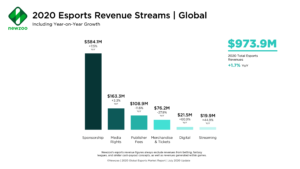The takeaways
- Gaming research firm Newzoo has revised esports’ global revenue estimates down by 8% to 973.9 million in 2020 and 1.2 billion in 2021.
- Advertisers have found it difficult to promote events without live physical audiences on top of budget cuts.
- Like other forms of streaming, esports has seen attendance rates increase while revenues fall due to the COVID-19 pandemic.
What happened?

Via Newzoo
Venturebeat reports an 8% fall in global esports revenues this week, according to gaming industry research firm Newzoo. Anticipated global revenue now stands at 973.9 million in 2020 and 1.2 billion in 2021.
Interconnected device and streaming usage have shot up since the global lockdowns and esports are no different. However, Newzoo identifies the attendant decline in live events due to safety orders as causing the downgrade. Indeed, their estimates show that US esports viewers will number 35 million in 2020, a 10% increase. Recently, Brazilian esports saw a boost when the WHO identified it as the newest COVID-19 epicenter. Esports publisher INTZ claimed its social media usage rose from 8.3M in February to 17.9M in April.
Elsewhere, the industry has experienced financial pressures in line with the economy. Esports platform Super League Gaming recently reported a $5.1 million loss for Q1 2020.
Why this matters
Both traditional sports and esports face challenges in growing revenues as the pandemic continues. Live events have been postponed, with employees and athletes taking pay cuts. Streaming packages, which normally rely on live sports to attract consumers, recently hiked prices to stay profitable. Many esports leagues now stream digital events, which is naturally less possible for its traditional counterparts.
Venturebeat notes that advertisers are slow to sponsor events without a live physical audience. They also conclude that the pandemic could lessen “excitement for digital versions of esports tournaments and musical performances.” With advertisers working with lower budgets, slowing economies and a reduced 2.4% rise in digital advertising spending, the actual audience to support ad-based programming remains in question.









